Cruise Day 45
Speed 0 knots (kts) (on station)
Course n/a
Location N. Canada Basin, ~553 nm north of Barrow, Alaska
Depth 3861 m
GO DEEPER DISCUSSION: (see previous journal for the questions.)
The extent of Arctic sea ice is relatively easy to measure from satellite photos, but finding ice thickness presents more of a challenge. Buoys like the one I discussed yesterday can help with this kind of determination but there are very few of them deployed at any time in the Arctic. Estimates of ice thickness can be made by satellite and when scientists in the Arctic make measurements of the ice it helps to confirm these estimates. All of these methods take more time and result in values less certain than the surface area of ice covering the Arctic Ocean.
TODAY’S JOURNAL:
We’ve settled in on our super station, with about three days’ worth of sampling operations. When it brightened enough to see around I surmised that the continuous ice we are in is mostly thin, probably formed in the last few weeks. Clumped here and there are thick pieces of ice that were recently adrift but have now frozen into the beginning of this winter’s ice pack. As the cruise gets deeper and deeper into September we are seeing the importance and value of spares, redundant systems, and the expertise to fix things. We had a few failed attempts with the GEOTRACES rosette due to broken instruments but the cast we tried this afternoon seems to have gone well. On board, engineers are working to fix one of the ship’s two freshwater systems. To have fresh water supplies, the ship uses a distilling system that basically boils seawater, rejects the remaining brine and condenses fresh water. Distilled water tastes kind of funny so tiny amounts of salts and minerals are added back to produce a nicely palatable water supply. For a few days now laundry has been limited and we’ve been instructed to take “sea showers.” This means you turn on the shower to wet down, turn it off, and soap up. Then you turn on the shower one more time to rinse off and you’re good to go! The galley has been issuing paper plates to cut down on dishwashing water as well. We are maintaining sustainable water usage this way, but I’ll admit a little longer shower sounds good after working in the wind and snow. Until then, I’ll certainly survive!
I forgot to follow up on the talent show two nights ago, which was a big hit for both the crew and the science team. Acts from both performed comedy, skits, dance, music, and even a video-taped painting show based on The Joy of Painting, a show that frequently is running on the mess deck TV during breakfast for some reason. The show was in the helicopter hanger – since we don’t have any aircraft aboard on this cruise the cavernous space is used for a floating rec center, movie theater, and storage/staging area for lots of science gear. The morale committee livened it up with lights and camping chairs, with the overflow crowd grabbing a stair tread or pallet box to watch the show from.
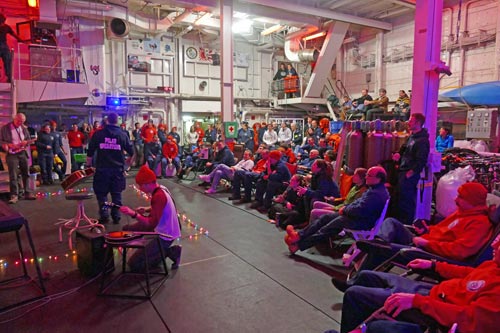 A talent show on Sept. 20 provided great entertainment for crew and science team alike!
A talent show on Sept. 20 provided great entertainment for crew and science team alike!
I caught up with my buddy Neil Wyatt, from London by way of Florida State University, to show me his lab setup in Healy’s main lab and explain what his role is. Neil is focusing on zinc, a trace metal present in small concentrations in sea water. Zinc is an example of a micronutrient – something that is important to living processes even though it is only found in tiny amounts. Perhaps most importantly for Arctic ecosystems, zinc is needed by photosynthesizing organisms such as phytoplankton. If insufficient amounts of a nutrient such as zinc are present it can be a limiting factor to growth at the base of the food web. Iron can famously limit phytoplankton production in ocean ecosystems, but zinc often runs second to that in terms of an oceanic limiting nutrient.
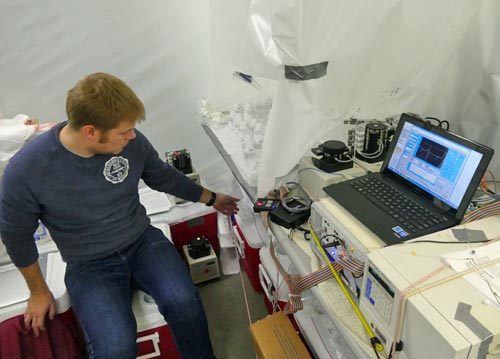 Neil Wyatt in the Healy’s main lab with his flow-Injection analysis system for studying zinc in sea water.
Neil Wyatt in the Healy’s main lab with his flow-Injection analysis system for studying zinc in sea water.
There’s another major role that zinc analysis plays on this cruise, and that is to detect possible contamination of samples. Normally, zinc is found at such small levels that it is measured in nanomolar (billionths of a mole per liter) or even sometimes picomolar (trillionths of a mole per liter) concentrations. Higher levels in a sample could indicate contamination from a metallic source such as the ship’s hull or a corroding steel part on the sampling apparatus. Neil also compares zinc levels between each of the two bottles on the GEOTRACES rosette that are closed at the same depth. If their zinc levels differ significantly it could indicate that the bottles weren’t closing properly or if one is experiencing contamination issues. The ability to test for zinc while underway gives our scientists the chance to review data as the expedition progresses and address any problems detected while there is time to do so. Waiting to get samples back to home labs certainly works fine for analysis but by having this check in place our sampling operations can work with the best chance of getting high quality data throughout the two+ months we are at sea.
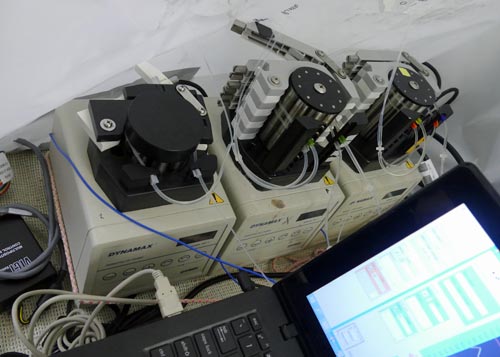 Computer-controlled pumps provide the proper amounts of reagent for the flow-injection analysis system.
Computer-controlled pumps provide the proper amounts of reagent for the flow-injection analysis system.
Neil’s system is really slick. His flow-injection analysis begins by running check standard solutions of known zinc concentrations to calibrate his system before running samples from the GEOTRACES rosette bottles. Water being tested is run through a computer-controlled pumping system that automatically adds chemical reagents to the water. The zinc in the sample is then trapped in a resin-filled cylinder, a process known as pre-concentration. Then the system switches to an acid rinse that mobilizes and runs the collected zinc compounds though a fluorescence detector. The concentration of zinc in a sample can be derived from digitally measuring the fluorescent output curve. The detector measures this fluorescent response three times for each sample to improve data reliability, and as a way of continually self-checking the process. (If the three curves aren’t nearly matched then Neil knows something is going wrong.) Additionally, Neil re-measures the check standard (water with a known zinc concentration) every 10 samples to look for any measurement drift or inconsistencies with the system. The ability to make measurements of zinc this precise at sea is very cutting-edge, and Neil is at the forefront of using this kind of technology aboard research vessels.
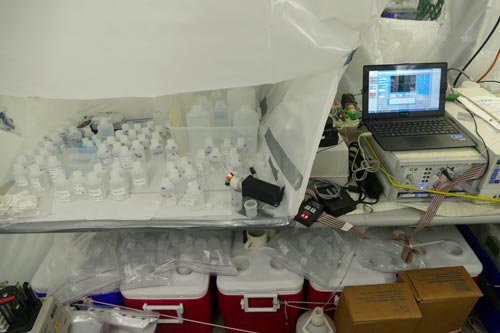 Neil’s flow-injection analysis system is set up in the bubble within Healy’s main lab.
Neil’s flow-injection analysis system is set up in the bubble within Healy’s main lab.
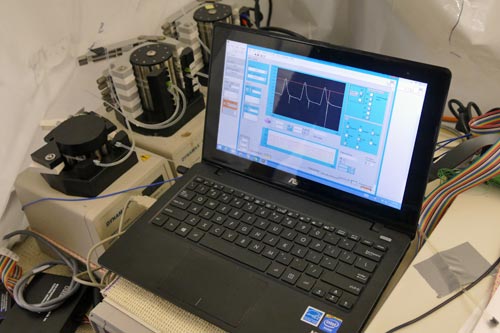 Three fluorescence output peaks for zinc are produced for each sample to increase reliability and make detecting measurement problems easier.
Three fluorescence output peaks for zinc are produced for each sample to increase reliability and make detecting measurement problems easier.
GO DEEPER!
What is a common item you may have at home or at school that has fluorescent properties?
Aloft Con web cam updated every hour
Healy Track
That's all for now. Best- Bill


Comments